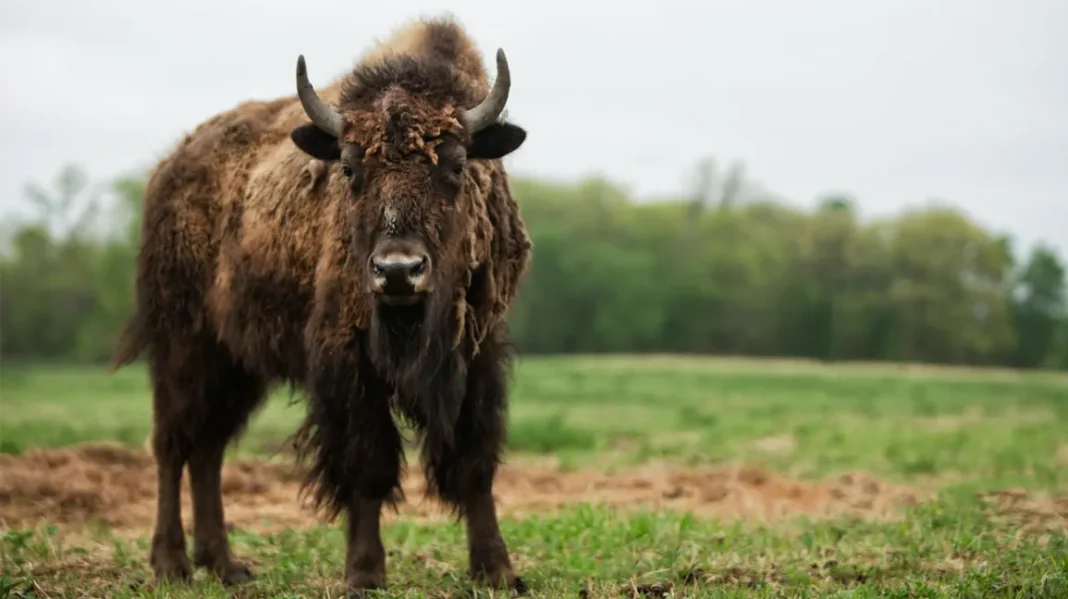Bison are one of over 100 species of hoofed mammals belonging to the Bovidae family, which also includes cattle.
While often grouped with buffalo, their anatomical features slightly differ.
Historically, bison has been the second most popular type of red meat, with beef being number one. Today, the demand for bison meat is growing due to increased marketing efforts, its widespread availability, and favorable nutritional profile.
This article reviews bison’s nutritional profile, benefits, and drawbacks and compares it with beef.
Nutrition
In terms of nutrient content, bison packs a good amount of several essential nutrients, including protein, iron, zinc, selenium, and B vitamins.
A serving of bison cooked from a raw, 113-gram (4-ounce) portion provides:
- Calories: 124
- Protein: 17 grams
- Fat: 6 grams
- Saturated fat: 2.5 grams
- Carbs: less than 1 gram
- Iron: 13% of the Daily Value (DV)
- Selenium: 31% of the DV
- Vitamin B12: 68% of the DV
- Zinc: 35% of the DV
- Vitamin B6: 19% of the DV
- Niacin (vitamin B3): 28% of the DV
SUMMARY
Bison, which is high in protein, B vitamins, and certain minerals, boasts a favorable nutritional profile.
Potential benefits
As part of a nutritious, whole-foods diet, bison may provide several potential health benefits.
Excellent source of protein
Providing around 17 grams of protein per raw 4-ounce (113-gram) serving, bison is considered an excellent source of protein.
Sufficient protein intake is essential for numerous processes in your body, including tissue rebuilding, hormone production, and nutrient transport (2Trusted Source, 3Trusted Source, 4Trusted Source).
The general recommendation for protein intake among active individuals is 0.6–0.9 grams per pound (1.4–2.0 grams per kg) of body weight. Thus, consuming bison is a good way to get closer to meeting this recommendation (5Trusted Source).
Rich source of B vitamins
Bison meat packs a good deal of B vitamins, with a raw 4-ounce (113-gram) serving providing 68%, 19%, and 28% of the DVs for vitamin B12, B6, and niacin (B3), respectively.
B vitamins are involved in many cellular processes throughout your body, including energy and neurochemical production, as well as red blood cell formation (6Trusted Source).
While B vitamins are widely available today due to the fortification of many foods, including bison meat in your diet can help you meet your daily needs.
High in iron, selenium, and zinc
In addition to its relatively high vitamin B content, bison is a good source of iron, as well as an excellent source of selenium and zinc, with one raw 4-ounce (113-gram) serving providing 13%, 31%, and 35% of the DV for each mineral, respectively.
These three essential minerals serve numerous important functions in your body.
Iron plays an important role in red blood cell formation. Red blood cells are the main transporters of oxygen in your blood and necessary for all oxygen-requiring processes (7Trusted Source, 8Trusted Source).
Selenium serves as an antioxidant that fights oxidative stress, which refers to an imbalance of free radicals and antioxidants that can lead to tissue dysfunction and disease. Adequate selenium intake can help prevent this (9Trusted Source, 10Trusted Source).
Meanwhile, zinc supports your body’s immune system and helps fight various illnesses. More specifically, it promotes cell division and growth, as well as wound healing. Proper zinc intake can help ensure optimal immune function (11Trusted Source).
Including bison as part of a balanced diet may help you meet the daily requirements for these three important minerals.
Fairly low in calories
When compared with many other meats, bison is low in fat and overall calories, with a raw 4-ounce (113-gram) serving providing 6 grams of fat and 124 calories.
By swapping out fattier cuts of meat for bison, you may be able to get the same amount of beneficial nutrients with fewer overall calories, which may be helpful for individuals looking to improve their body composition or lose weight.
Can be substituted in recipes
In addition to bison’s impressive nutritional profile and mild flavor, it can be versatile in the kitchen.
For example, you can use it as a substitute for other red meats in almost any recipe, including those for chilis, stews, and stir-fries.
Bison is also commonly consumed as a steak or roast and can be cooked similarly to other lean red meats.
SUMMARY
Due to bison’s rich nutrient profile, it may provide a number of health benefits, such as promoting a healthy body weight and muscle mass, when eaten in moderation as part of a healthy diet.
Downsides to consider
While eating bison on a regular basis may come with several potential benefits, it has a couple of drawbacks to consider.
Price
One major drawback of regularly eating bison is that it can be expensive in most areas. This is due to market prices set in relation to supply and demand.
Furthermore, the cost of grass-fed bison tends to be higher than that of grass-fed beef, though this may also vary by demographic area.
Traditionally farmed beef tends to be the least expensive due to large-scale farming, though the nutritional profile of this meat is likely different (12Trusted Source).
Some simple ways to enjoy bison despite its higher cost include buying the meat in bulk or when it’s on sale.
Easy to overcook
Given that bison is considerably leaner than other types of red meat, such as beef, it’s easier to overcook, which could result in a dry, tough, and hard-to-chew meal.
Though this mainly applies to steaks and whole-muscle cuts, ground bison may also require slightly less cooking than other types of red meat.
One way to regulate cooking time is to use a food thermometer. Ground bison should be cooked to an internal temperature of 160ºF (71ºC), whereas steaks and roasts should reach a minimum temperature of 145ºF (63ºC) (13).
Overcooking can also be avoided by using a slightly lower flame or cooking temperature.
As when trying any new food, cooking bison to your preferred doneness may take a bit of practice.
SUMMARY
Though consuming bison meat comes with several nutritional benefits, there are a couple of drawbacks to keep in mind, such as its slightly higher price and the fact that it’s easier to overcook.
Bison vs. beef
While bison and beef share many qualities, there are some subtle differences between them.
Bison tends to be leaner than beef, making it a bit lower in calories and easier to overcook.
In terms of taste, bison and beef are similar, though based on different cuts of meat, you may notice a slight difference in flavor and texture.
Farming method is another area in which the two types may differ. The majority of beef is produced using factory farming with grain as feed, a practice that promotes rapid weight gain and growth (12Trusted Source, 15Trusted Source).
Meanwhile, bison is usually grass-fed and pasture-raised, though as the demand for it increases, some farmers are supplementing with grain feed.
That said, both bison and beef, whether grass-fed or grain-fed, can be a nutritious part of an overall healthy diet.
SUMMARY
Bison and beef are two types of red meat that share many similarities, the main ones being nutrient profile and taste. Some differences between them include texture, farming methods, and leanness.
The bottom line
Like cattle, bison are members of the Bovidae family of hoofed mammals.
While bison meat is similar to beef, it differs slightly, with the former being leaner and usually grass-fed.
Its favorable nutritional profile may promote overall health, and its versatility makes it a viable alternative to other red meats.
All things considered, bison can be a nutritious addition to a well-balanced, whole-foods diet.



